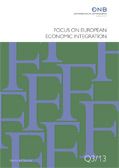Focus on European Economic Integration Q1/20
 OeNB
OeNB
- published:
- February 2020
 OeNB
OeNB
Focus on European Economic Integration Q1/20 (PDF, 3 MB) February 2020
Call for applications: Klaus Liebscher Economic Research Scholarship (PDF, 76 kB) de en Feb 28, 2020, 12:00:00 AM
The refinancing of CESEE banking sectors: What has changed since the global financial crisis?
(PDF, 708 kB)
Lahnsteiner.
We systematically analyze the liability structure of banking sectors in Central, Eastern and Southeastern Europe (CESEE) in a cross-country perspective over a decade (2008–2018). The refinancing structures have materially transformed since the start of the global financial crisis (GFC), as witnessed by a marked decline of net foreign liabilities (NFL) in % of GDP in various countries. Turkey represents a notable exception from this general trend, as its banking sector has accumulated net foreign liabilities – to an extent comparable to the levels seen in some CESEE EU Member States before the GFC. The general NFL reduction was in some cases partly driven by a shrinking credit stock (in % of GDP or even nominally) and, in almost all cases, partly or fully driven by increasing domestic deposits. Hence, most CESEE banking sectors saw a shift in their funding structure from net foreign liabilities to domestic deposits. At the same time, the share of overnight deposits in total liabilities increased considerably in many countries.
It is also noteworthy that the gaps between foreign currency loans and foreign currency deposits narrowed or even disappeared, so that foreign currency loans no longer surpass foreign currency deposits at the current stage (or only slightly so). Looking ahead, deposits will likely continue to grow (as long as the high nominal wage growth is maintained), but banks in the EU will have to adapt their funding structure to the new regulatory environment by issuing bonds that are eligible under the minimum requirement for own funds and eligible liabilities (MREL). Hence, the role of debt securities is expected to increase from a very low level.
en
financial stability, banking sector, Central and Eastern Europe, refinancing, capital flows, deposits, financial crisis
G15, G21, G32, O16, O52
Feb 28, 2020, 12:00:00 AM
China’s New Silk Road: a stocktaking update and economic review (2017–2019) (PDF, 1.6 MB) Barisitz. This study is an update of an initial overview by Barisitz and Radzyner (2017a) in the present journal. The Belt and Road Initiative (BRI) corresponds to an enormous international infrastructure investment program focusing on Asia, Africa and Europe. BRI projects are predominantly credit-based and financed by Chinese sources. So far, about USD 450 billion have been spent or earmarked. While not without setbacks and substantial risks, many BRI projects appear to have progressed since 2017. The present project-oriented update attempts to fill a void and shed some light on a number of key undertakings in the above three global regions. Against the backdrop of the evolving U.S.-China trade conflict, the BRI may ultimately provide China with an alternative geo-economic perspective. en New Silk Road, Belt and Road Initiative, connectivity, transportation, trade infrastructure, energy, digital, economic corridors, regional policy, China, Eurasia, Africa F15, F34, N75, R12, R42 Feb 28, 2020, 12:00:00 AM
The sensitivity of banks’ net interest margins to interest rate conditions in CESEE (PDF, 820 kB) Allinger, Wörz. Since the global financial crisis, the relationship between monetary policy and banks’ net interest margins (NIMs) has been investigated in many studies, not least in light of the low interest rate environment. However, to our knowledge, this is the first econometric study that explores this topic for the Central, Eastern and Southeastern European (CESEE) economies. Using banklevel data for 15 CESEE countries from 2006 to 2018, we assess the effect of the interest rate environment on banks’ NIMs. Our policy rate variable takes into account both the domestic and the international interest rate environment (euro area, U.S.A. and Switzerland). To construct this variable, we use the shares of foreign and domestic currency loans in total bank loans extended to the domestic private sector as weights for the interbank rates of the different jurisdictions. Our results show that lower (weighted) interest rates lead to lower NIMs and that the effect is nonlinear, i.e. it becomes more pronounced as the level of interest rates falls. This finding is in line with the existing literature on other, more advanced economies. As net interest income (NII) is the key revenue component of banks, especially given the traditional lending and deposit-taking business model prevalent in the CESEE banking sectors, we conclude that both pressures on NIMs and the development of interest rates in the region and worldwide should be monitored closely. en low interest rates, monetary policy rate, bank profitability, Central, Eastern and Southeastern Europe E43, E52, G21 Feb 28, 2020, 12:00:00 AM
Conference on European Economic Integration (CEEI) 2019 – Looking back on 30 years of transition – and looking 30 years ahead (PDF, 172 kB) de Feb 28, 2020, 12:00:00 AM
17th ESCB Emerging Markets Workshop (PDF, 130 kB) de Feb 28, 2020, 12:00:00 AM
Referees for Focus on European Economic Integration 2017−2019 (PDF, 112 kB) de Feb 28, 2020, 12:00:00 AM